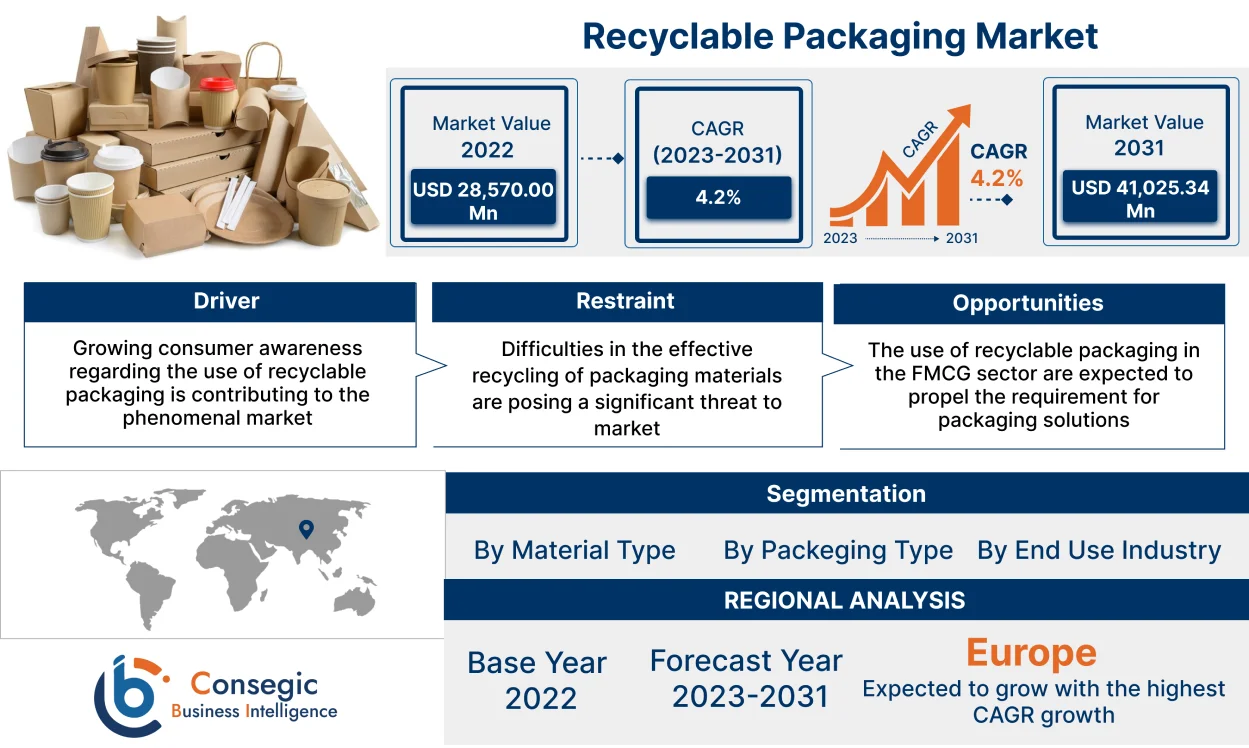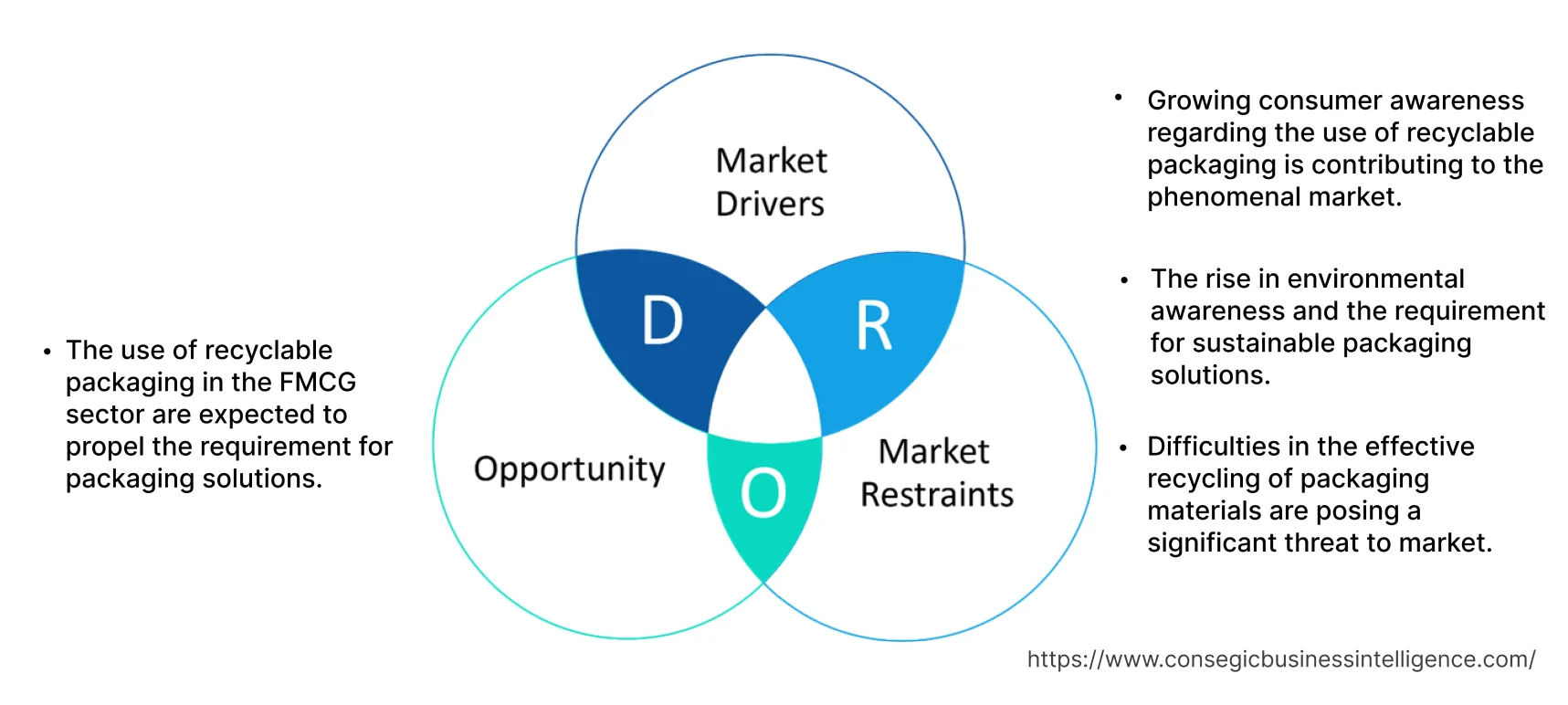- Summary
- Table Of Content
- Methodology
Recyclable Packaging Market Scope & Overview:
Recyclable packaging refers to materials that can be reprocessed into new products after their initial use, reducing environmental impact and fostering sustainability.
These packages are designed to minimize waste and pollution, contributing to a circular economy. Their key characteristic lies in their ability to be easily sorted, processed, and transformed into new materials or products.
These packaging solutions encompass a wide range of materials, including cardboard, glass, plastics, such as PET or HDPE, aluminum, and paper. Their applications span various industries, from food and beverage packaging to electronics, cosmetics, and beyond. Additionally, based on the analysis, these materials not only minimizes landfill waste but also conserves energy and natural resources by reducing the need for raw materials in the production of new packaging.
Recyclable Packaging Market Size :
The Recyclable Packaging Market is projected to grow at a CAGR of 4.2% during the forecast period (2023–2031). The market was valued at USD 29,487.99 million in 2023 and is expected to reach USD 41,025.34 million by 2031.
Global Recyclable Packaging Market Insights :
Recyclable Packaging Market Dynamics - (DRO) :
Key Drivers :
Growing consumer awareness regarding the use of recyclable packaging is contributing to the phenomenal market
The significant rise in consumer awareness regarding the recycling of products serves as the potential factor fueling the recyclable packing market demand. Consumers are increasingly prioritizing sustainable products and brands that demonstrate environmental commitment. Hence, this packaging is becoming an influencing factor regarding purchasing decisions.
Changing consumer preferences towards eco-friendly products are prompting businesses to adopt these packaging technologies. Additionally, consumers are willing to pay more for products packaged sustainably, encouraging companies to invest in recyclable alternatives.
For instance,
- On September 06, 2022, According to the report published by the United States Department of Agriculture, "Zero Waste" is one of the top five consumer trends in Germany 2022-2023 and more than 2/3rd of German consumers are calling on companies to act environmentally conscious as possible, by incorporating environment-friendly measures.
As a result, rising consumer awareness about environmental protection is escalating the requirement for recyclable packaging market growth and trends.
The rise in environmental awareness and the requirement for sustainable packaging solutions
Rising environmental awareness and the requirement for sustainable packaging solutions is one of the prominent factors fueling market. Sustainable packaging solutions aim to reduce the environmental footprint by utilizing materials that are renewable, recyclable, biodegradable, or compostable. They are designed to minimize waste generation, pollution, and energy consumption throughout the packaging lifecycle.
As per the analysis, the packaging market has an indirect and direct impact on every industry trend, including personal care, pharmaceuticals, food and beverage, medicine, and healthcare. The rising need for eco-friendly and healthy products that are not only of good quality but also packaged responsibly is driving the market growth. This requirement is pushing companies to reevaluate their packaging strategies.
Owing to this, many brands are actively transitioning towards eco-friendly packaging to meet consumer expectations and demonstrate corporate social responsibility. Furthermore, sector initiatives promoting sustainable practices are influencing businesses to adopt more environmentally friendly packaging options.
For instance,
- In November 2023, JBM Packaging, a manufacturer of eco-friendly, flexible packaging solutions, launched HydrobloxTM, an uncoated, water-resistant recyclable packaging paper.
Consequently, rise in environmental awareness and the requirement for sustainable packaging solutions are fostering the requirement for packaging.
Key Restraints :
Difficulties in the effective recycling of packaging materials are posing a significant threat to market
Disadvantages and problems associated with the recycling of packaging materials such as high initial costs, quality, and performance concerns are hampering the recyclable packaging market trend. Recyclable materials often require specialized processing and equipment. Transitioning to recyclable materials or innovative eco-friendly packaging solutions is sometimes more expensive to produce compared to traditional packaging materials. This cost difference deters some companies from making a complete switch to this packaging, especially for budget-conscious businesses.
Additionally, some recyclable materials do not possess the same durability, shelf-life, or protective qualities as traditional packaging. Ensuring that the packaging maintains product quality, safety, and integrity throughout the supply chain is a major challenge. Moreover, some types of packaging, such as multi-material packaging, are difficult to recycle efficiently. This is because the different materials need to be separated before they can be recycled, which is a complex and expensive process.
For instance,
- According to the data provided by the UN Environment Programme, of the 7 billion tonnes of plastic waste generated globally so far, only less than 10 % is recycled and estimated annual loss in the value of plastic packaging waste during sorting and processing alone is USD 80- 120 billion.
As a result, problems associated with the recycling of packaging materials are restraining the market.
Future Opportunities :
The use of recyclable packaging in the FMCG sector are expected to propel the requirement for packaging solutions.
Fast-moving consumer goods are products that sell quickly at relatively low cost. These goods are also called consumer packaged goods. This sector incorporates household products, food and beverage products and homecare products among others. Utilizing recyclable packages in consumer goods offers cost-effective advantages in its use for the long run. Additionally, the rising consumer awareness regarding environmental health is also increasing the requirement for sustainable and packaging solutions for goods.
Furthermore, the expanding FMCG industry is expected to fuel the need for packaging solutions, further boosting the market.
For instance,
- According to the data published by the India Brand Equity Foundation, in August 2023, the FMCG market in India reached USD 56.8 billion as of December 2022. Total revenue of the FMCG market is expected to grow at a CAGR of 27.9% through 2021-27, reaching nearly USD 615.87 billion, in turn increasing the demand for recyclable packaging over the forecast period.
As a result, the rising consumer foods sector is expected to fuel the recyclable packaging market opportunities and trends.
Top Key Players & Market Share Insights :
The global recyclable packaging industry is highly competitive, with several large players and numerous small and medium-sized enterprises. These companies have strong research and development capabilities and a strong presence in the market through their extensive product portfolios and distribution networks. The market is characterized by intense competition, with companies focusing on expanding their product offerings and increasing their market share through mergers, acquisitions, and partnerships. The key players in the market include-
- Amcor plc
- Emmerson Packaging
- Tetra Laval
- Ardagh Group SA
- Better Packaging Co.
- Ball Corporation
- Elopak AS
- Emerald Packaging
- Nampak
- JBM Packaging
- Smurfit Kappa
- GWP Group
- Logos Pack
- GWP Group
- PlastiPak Holdings Inc.
- Sealed Air Corporation
- WestRock Company
- Be Green Packaging
- DS Smith
- DuPont
- Mondi
- Bemis Company
Recyclable Packaging Market Segmental Analysis :
By Material Type :
The material type is categorized into paper, wood, glass, plastic, metal, and others. In 2022, the paper segment accounted for the highest recyclable packaging market share of 38.86% in the recyclable packaging market. Paper is an incredibly versatile and extensively used material in packaging due to its flexibility to create various types of packaging such as cardboard boxes, cartons, paper bags, wrapping paper, and more. Paper is valued for its lightweight, yet sturdy properties, making it suitable for various products across industries. One of the significant advantages of paper-based packaging is recyclability. Recycled paper fibres are potentially utilized to produce new paper-based packaging products, reducing the requirement for virgin materials and minimizing environmental impact. Additionally, compared to many other packaging materials, paper has a much lower environmental impact as it is made from a renewable resource (trees) and often requires less energy and water to produce than other alternative materials. As a result, as per the recyclable packaging market analysis, owing to the several benefits provided by paper the segment is gaining significant expansion.
Moreover, the plastic segment is expected to hold the fastest CAGR over the forecast period. Common recyclable plastics include PET (polyethylene terephthalate, used in bottles), HDPE (high-density polyethylene, often used in containers), PVC (polyvinyl chloride), LDPE (low-density polyethylene), PP (polypropylene), and PS (polystyrene). As the mission for more sustainable plastic packaging is ongoing, exciting new technologies such as chemical recycling and bioplastics are expected to bring new opportunities to the recyclable packaging market. Furthermore, an increase in the adoption and recycling of plastic packaging is expected to fuel the segment's expansion.
For instance,
- In October 2023, Coca-Cola announced the launch of its cola brand Coca-Cola in rPET bottles in pack sizes of 250 ml and 750 ml. According to the company, the bottles are made from 100% food-grade rPET excluding caps and labels, and will drive consumer awareness on the packs.
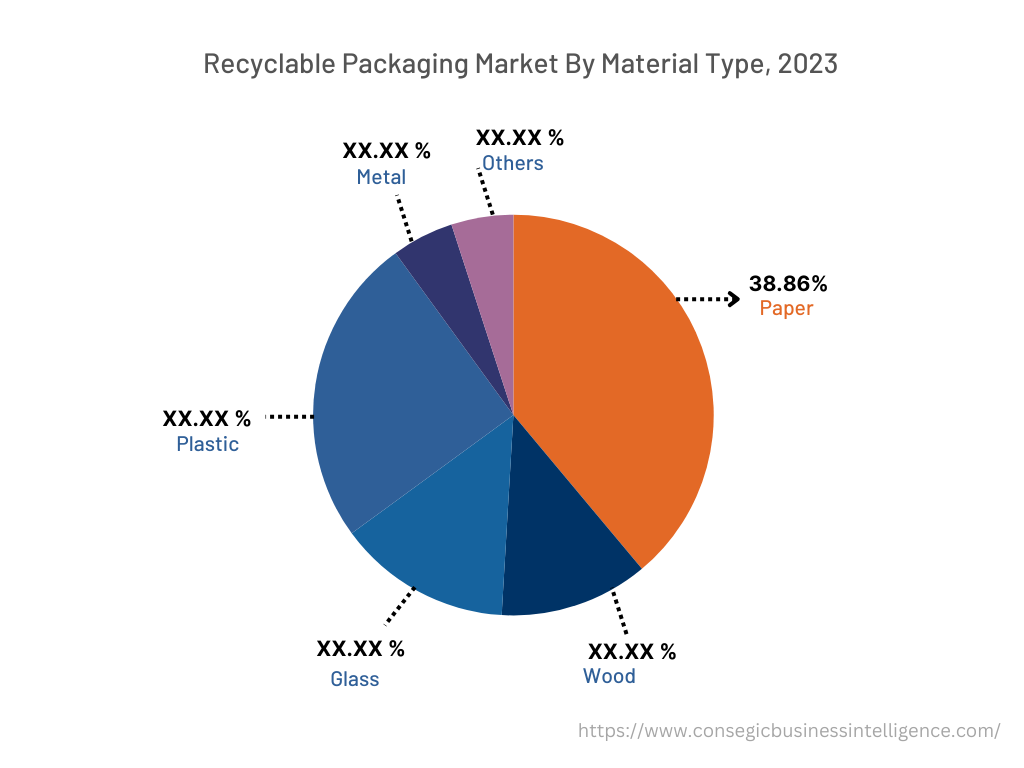
Thus, the rising use of recyclable plastic for packaging trends is expected to fuel the segment's expansion.
By Packaging Type :
The packaging type is categorized into flexible and non-flexible. In 2022, the flexible segment accounted for the highest market share in the recyclable packaging market and is also expected to hold the fastest CAGR over the forecast period. Flexible packaging refers to the packaging materials that can conform to the shape of the product being packaged. Flexible packaging reduces product damage as it can be easily molded and the product can be stored according to convenience. Additionally, flexible packaging is highly customizable, cost-effective, lightweight, and offers enhanced product preservation. Moreover, flexible packaging material provides enhanced sustainability as the materials used for flexible packaging are recyclable and compostable. Furthermore, the rising adoption of flexible packaging by packaging companies is expected to increase its requirement.
For instance,
- In October 2023, Pakka launched India's first compostable flexible packaging in collaboration with Brawny Bear, India's pioneer in date-based food manufacturing to enhance the sustainability of products.
Thus innovative recyclable and flexible plastic solution for packaging is expected to propel the flexible packaging segment.
By End Use Industry :
The end-use industries segment is categorized into food and beverage, pharmaceuticals, cosmetics and personal care, and others. In 2022, the food and beverage segment accounted for the highest market share in the overall recyclable packaging market. Packaging within the food and beverage sector serves multiple critical roles beyond just containing and protecting products. It plays a pivotal role in preserving freshness, extending shelf life, ensuring safety, providing information to consumers, and influencing purchasing decisions. Additionally, effective packaging of products preserves the quality, flavour, and nutritional value of food and beverages by creating a barrier against environmental factors like moisture, oxygen, and light. In the food and beverage sector, these packaging plays a crucial role in addressing environmental concerns while ensuring the safety and preservation of products. These packaging solutions in this sector aim to reduce waste, promote sustainability, and meet consumer demands for eco-friendly options. Similarly, the expanding food and beverage sector is increasing the requirement for such packaging which is potentially fueling the segment growth.
Moreover, the cosmetics and personal care segment is expected to hold the fastest CAGR over the forecast period. Cosmetics and packaging go hand-in-hand, with each element playing a crucial role in the success of a product. Cosmetic packaging is often the first physical interaction a customer has with a brand. Eye-catching designs, luxurious materials, and innovative formats grab the attention, convey brand values, and create a lasting positive impression. Additionally, the packaging of cosmetics and personal care products plays a vital role in protecting the product from damage, contamination, and environmental factors like light, and moisture. This ensures the product maintains its quality, efficacy, and safety for consumers. Similarly, refillable containers and reusable packaging components are gaining popularity, allowing consumers to refill their favorite products while minimizing waste, hence effectively recycling the packaging. Furthermore, the growing cosmetics sector is expected to boost the recyclable packaging market demand.
For instance,
- According to the data published by the International Trade Administration on May 07, 2022, the cosmetics market in Canada generated approximately USD 1.24 billion in revenue in 2021 and it is expected to grow by 1.45% annually to reach USD 1.8 billion by 2024. This increases the demand for recyclable packaging in the cosmetic industry over the forecast period.
Thus, the growing cosmetics sector is expected to bring new growth opportunities to the segment.
Recyclable Packaging Market Report Insights :
| Report Attributes | Report Details |
| Study Timeline | 2017-2031 |
| Market Size in 2031 (USD Million) | USD 41,025.34 Million |
| CAGR (2023-2031) | 4.2% |
| By Material Type | Paper, Wood, Glass, Plastic, Metal, and Others |
| By Packaging Type | Flexible and Non-flexible |
| By End Use Industry | Food and Beverage, Pharmaceuticals, Cosmetics and Personal Care, and Others |
| By Region | North America, Europe, Asia Pacific, Latin America, and Middle East & Africa |
| Key Players | Amcor plc, Emmerson Packaging, GWP Group, Logos Pack, Swisspac Packaging, Tetra Laval, Ardagh Group SA, Better Packaging Co., Ball Corporation, Elopak AS, Emerald Packaging, PlastiPak Holdings Inc., Sealed Air Corporation, WestRock Company, Be Green Packaging, DS Smith, DuPont, Mondi, Bemis Company, Nampak, JBM Packaging, and Smurfit Kappa |
By Region :
The regional segment includes North America, Europe, Asia Pacific, the Middle East and Africa, and Latin America.
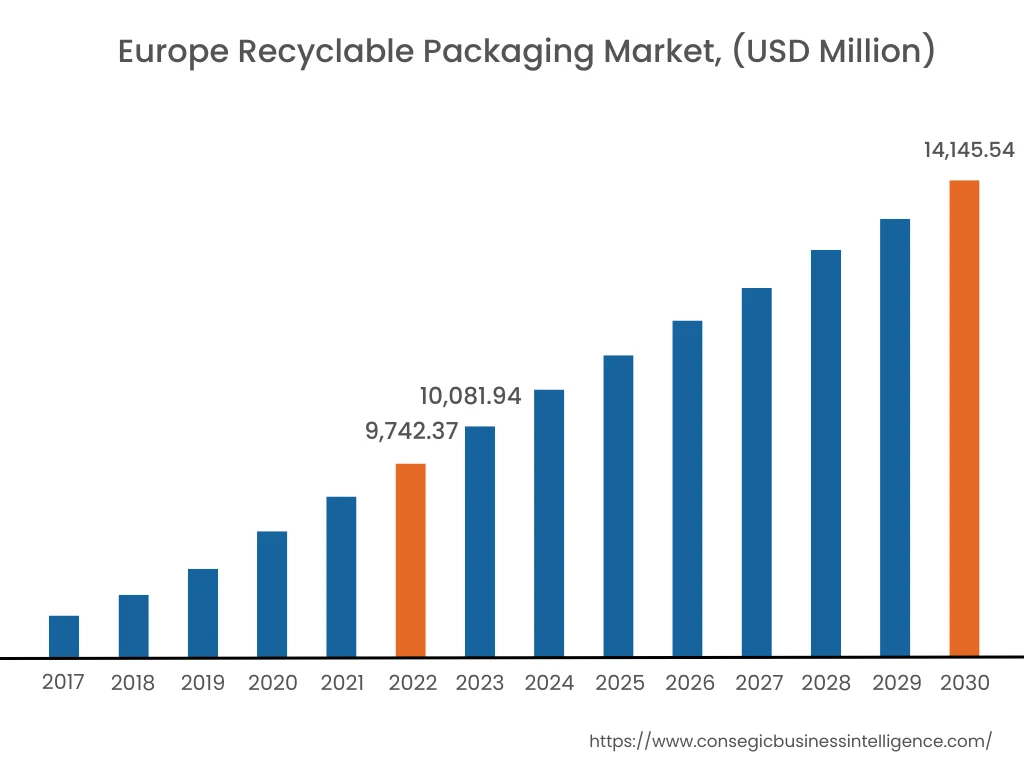
In 2022, Europe accounted for the highest market share at 34.10% valued at USD 9,742.37 Million in 2022 and USD 10,081.94 Million in 2023, it is expected to reach USD 14,145.54 Million in 2031. In Europe, Germany accounted for a major market share of 23.07% in the year 2022. The recyclable packaging market across the European region is growing owing to government initiatives and strict regulations like the packaging and packaging waste directive, promoting the use of recyclable materials and encouraging manufacturers to take responsibility for post-consumer packaging waste. These regulations incentivize innovation and adoption of sustainable packaging solutions. Additionally, the increasing consumer awareness and recycling of products in this region is creating strong market demand for these packaging, driving companies to cater to these preferences. Moreover, Europe possesses several prominent players in the packaging sector, with concentrated expertise in research and development, promoting continuous advancements in packaging technologies. As a result, owing to the above mentioned factors, the European region is gaining significant dominance in the recyclable packaging market trends.
Furthermore, the Asia Pacific region is expected to witness significant growth over the forecast period, growing at a CAGR of 4.9% during 2023-2031. The significant economic growth in urbanization and the well-established number of consumers for goods are expected to increase the demand for recyclable packaging across the region. Additionally, growing environmental consciousness is expected to promote the demand for recyclable packaging in industries in the Asia Pacific region.
For instance,
- According to the report by the Public Information Bureau in June 2022, India has banned the manufacture, import, stocking, distribution, sale and use of identified single-use plastic items, which have low utility and high littering potential, all across the country from July 1, 2022. Thus, the increasing initiatives by the governments of the countries in the Asia Pacific are expected to fuel the demand for recyclable packaging further boosting the market growth.
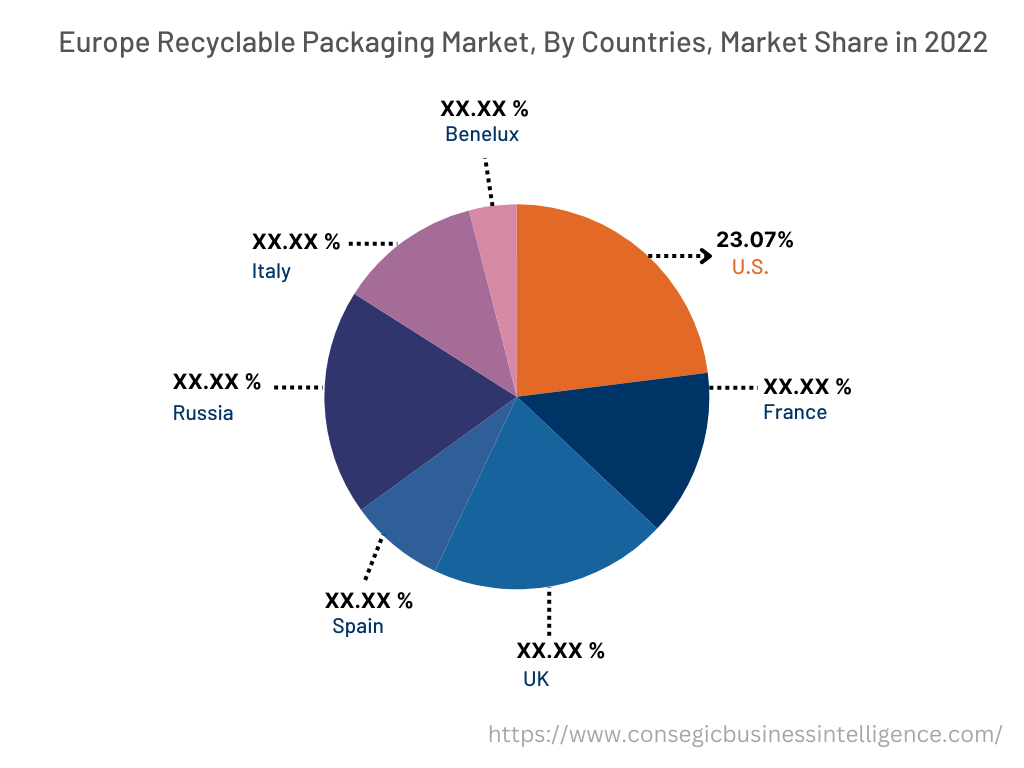
Recent Industry Developments :
- In September 2023, Smurfit Kappa made an agreement to buy WestRock company, for USD 11 billion to create the world's biggest paper and packaging company and try to better navigate weak economies on both sides of the Atlantic. The deal will combine Europe's biggest paper and packaging producer with the second-largest player in the United States and forge a company worth nearly USD 20 billion.
- In August 2023, Amcor a global leader in developing and producing responsible packaging solutions, announced an acquisition to acquire Phoenix Flexibles, expanding Amcor's capacity in the high-growth Indian market. Phoenix Flexibles has one plant located in Gujarat, India, and the business generates annual revenue of approximately USD 20 million from the sale of flexible packaging for food, home care, and personal care applications.
Key Questions Answered in the Report
What was the market size of the recyclable packaging market in 2022? +
In 2022, the market size of recyclable packaging was USD 28,570.00 million.
What will be the potential market valuation for the recyclable packaging industry by 2031? +
In 2031, the market size of recyclable packaging will be expected to reach USD 41,025.34 million.
What are the key factors driving the growth of the recyclable packaging market? +
Increasing environmental awareness and the demand for sustainable packaging solutions are driving the recyclable packaging market. Growing consumer awareness regarding the use of recyclable packaging is fuelling the market growth.
What is the dominant segment in the recyclable packaging market for the material type? +
In 2022, the paper segment accounted for the highest market share of 38.86% in the overall recyclable packaging market.
Based on current market trends and future predictions, which geographical region is the dominating region in the recyclable packaging market? +
Europe accounted for the highest market share in the overall market.
